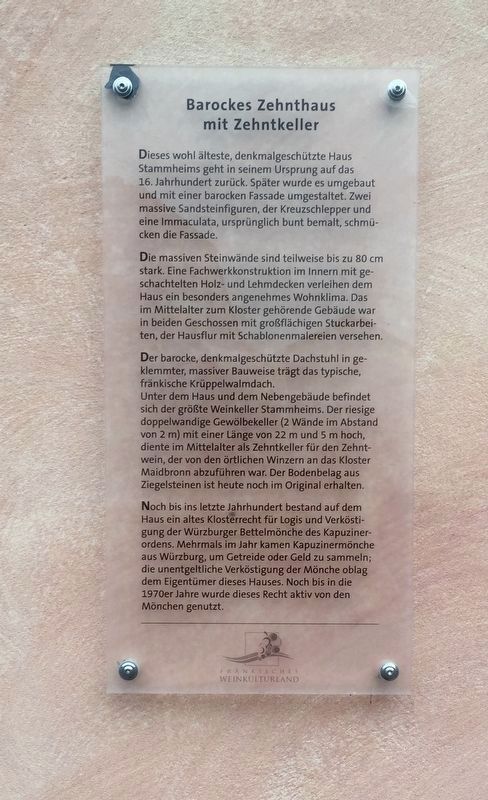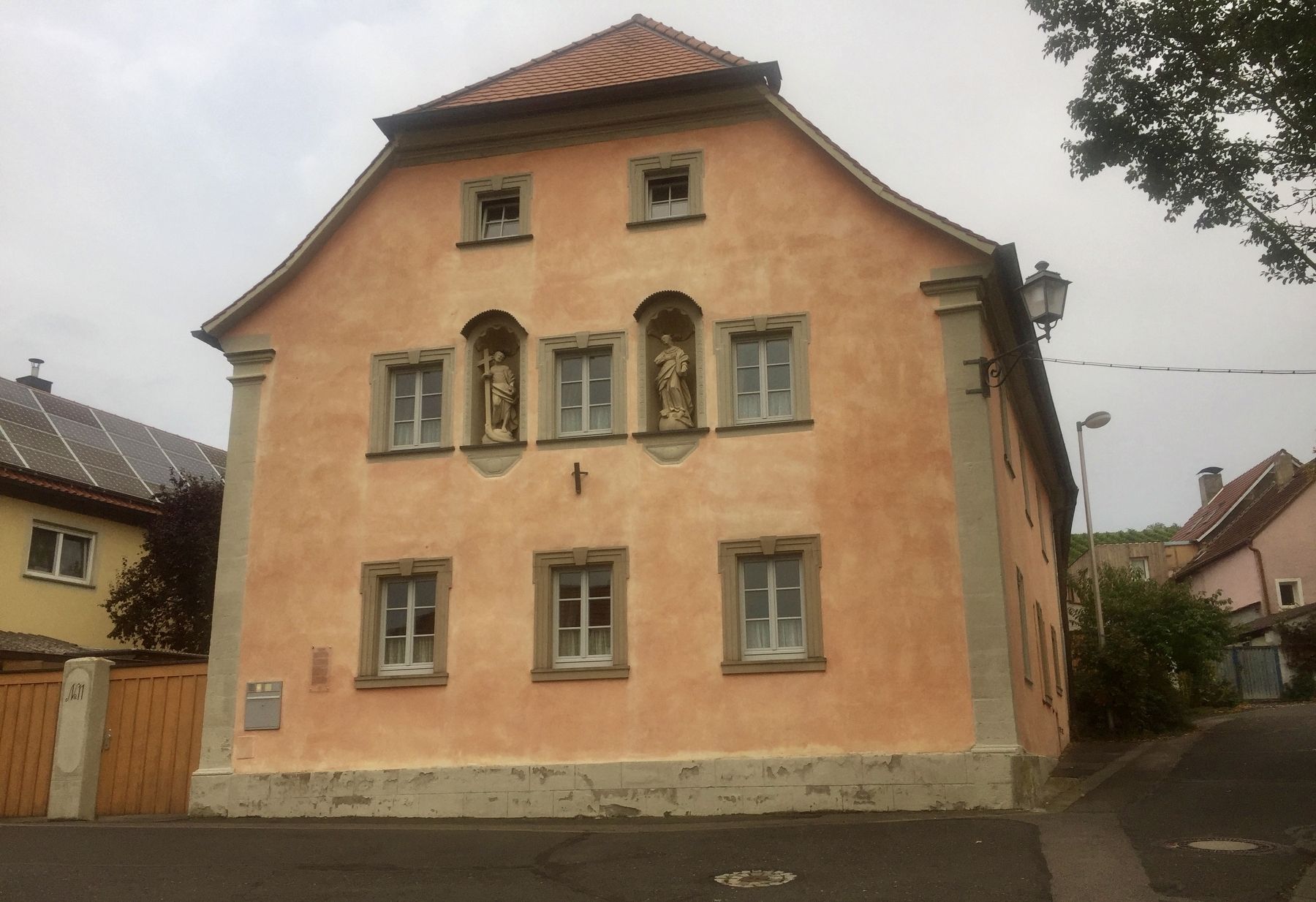Barockes Zehnthaus mit Zehntkeller / Baroque Tithing House with Tithe Cellar
Die massiven Steinwände sind teilweise bis zu 80 cm stark. Eine Fachwerkkonstruktion im Innern mit geschachtelten Holz- und Lehmdecken verleihen dem Haus ein besonders angenehmes Wohnklima. Das im Mittelalter zum Kloster gehörende Gebäude war in beiden Geschossen mit großflächigen Stuckarbeiten, der Hausflur mit Schablonenmalereien versehen.
Der barocke, denkmalgeschützte Dachstuhl in geklemmter, massiver Bauweise trägt das typische, fränkische Krüppelwalmdach. Unter dem Haus und dem Nebengebäude befindet sich der größte Weinkeller Stammheims. Der riesige doppelwandige Gewölbekeller (2 Wände im Abstand von 2 m) mit einer Länge von 22 m und 5 m hoch, diente im Mittelalter als Zehntkeller für den Zehntwein, der von den örtlichen Winzern an das Kloster Maidbronn abzuführen war. Der Bodenbelag aus Ziegelsteinen ist
heute noch im Original erhalten.Noch bis ins letzte Jahrhundert bestand auf dem Haus ein altes Klosterrecht für Logis und Verköstigung der Würzburger Bettelmönche des Kapuziner- ordens. Mehrmals im Jahr kamen Kapuzinermönche aus Würzburg, um Getreide oder Geld zu sammeln; die unentgeltliche Verköstigung der Mönche oblag dem Eigentümer dieses Hauses. Noch bis in die 1970er Jahre wurde dieses Recht aktiv von den Mönchen genutzt.
-
This building, probably the oldest, listed building of Stammheim dates back to the 16th century. Later, it was rebuilt and redesigned with a baroque façade. Two massive sandstone figures, the "Cross-bearer" and an Immaculata, originally colorfully painted, decorate the facade.
The massive stone walls are up to 80 cm thick in some places.
A truss structure inside, with nested wood and clay ceilings, makes the
house a particularly pleasant living environment. Belonging to a monastery in the Middle Ages, both floors of the building were decorated with grand stucco work, and the hallway adorned with stencil artwork.
The solidly constructed, listed, baroque roof is of the typical Franconian hipped design.
Located under the house and the outbuildingis the largest wine cellar in Stammheim. The huge
double-walled vaulted cellar (2 walls with two meters in-between), with a length
Until the last century, the house carried an old monastery-right for the lodging and feeding of the Würzburg mendicant monks of the Capuchin Order. Several times a year, Capuchin monks came from Würzburg to collect grain or money; the owner of the house was obligated to provide this to the monks free of charge. Until the 1970s, this right was actively used by the monks.
Topics. This historical marker is listed in these topic lists: Architecture • Churches & Religion.
Location. 49° 54.246′ N, 10° 11.54′ E. Marker is in Stammheim, Bayern (Bavaria), in Schweinfurt. Marker is at the intersection of Kirchweg and Mainstrasse, on the left when traveling south on Kirchweg. Touch for map. Marker is at or near this postal address: Kirchweg 11, Stammheim BY 97509, Germany. Touch for directions.
Other nearby markers. At least 8 other markers are within 3 kilometers of this marker, measured as the crow flies. Hofportal mit Bacchusrelief / Courtyard Entry with Bacchus Carving (within shouting distance of this marker); Das Historisches Rathaus / The Historic Town Hall (about 120 meters away, measured in a direct line); Wein-Kult Tour bei Stammheim / Wine Cult-Tour in Stammheim
Credits. This page was last revised on January 28, 2022. It was originally submitted on November 5, 2019, by Andrew Ruppenstein of Lamorinda, California. This page has been viewed 120 times since then and 6 times this year. Photos: 1, 2. submitted on November 5, 2019, by Andrew Ruppenstein of Lamorinda, California.

